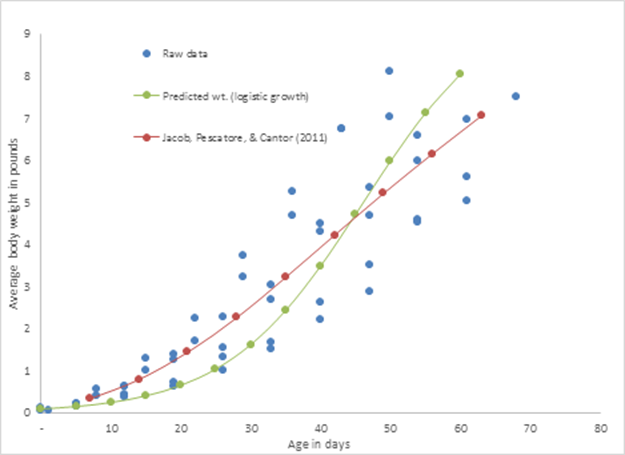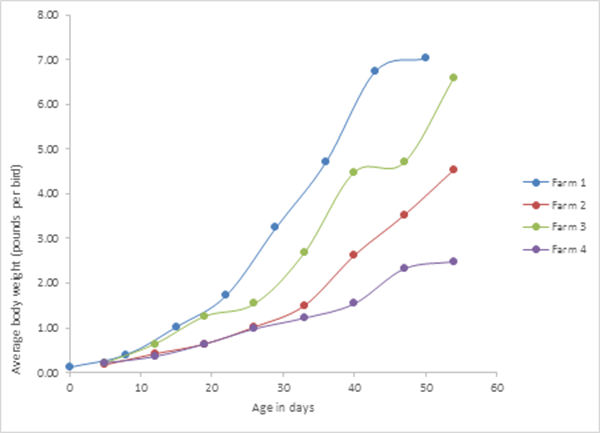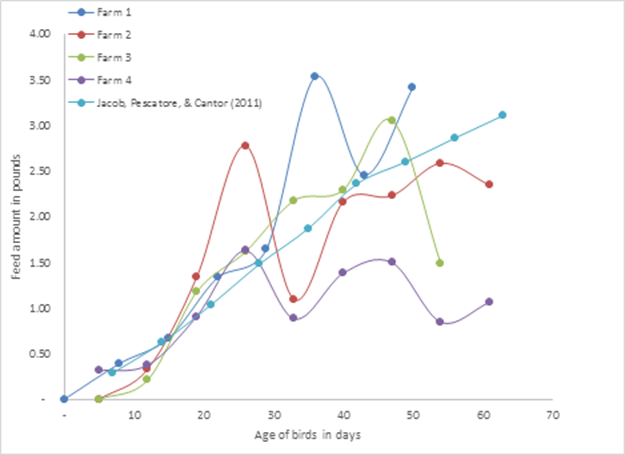 |
October 2016
|
October 2016 // Volume 54 // Number 5 // Research In Brief // v54-5rb4
Costs of Pastured Broiler Operations Based on Data from Small-Scale Farms
Abstract
Many small-scale and limited-resource farmers use "hobby scale" technologies to produce food for home consumption and as a source of supplementary income. However, the economic potential of many of these technologies has not been investigated. Raising poultry on pasture is a relatively common small-scale technology for which there is sparse production and economics information based on actual-farm data. This article provides such information, based on data from farms in Kentucky. Analysis indicated that live broiler sales might be marginally profitable but that greater profit can be realized through sales of processed broilers at farmers' markets.
Introduction
Many Extension personnel are aware that small-scale and limited-resource farmers sometimes adopt technologies for which little economics information exists. Some of these technologies are viewed as more suitable for producing food for at-home consumption than for commercial sales. Because this "at-home consumption" (or "hobby farming") aspect can discourage economic analyses of these technologies, Extension personnel are left in a quandary when farmers request advice about whether they save or waste money by using them.
One such technology is pastured poultry production (also called pastured poultry), a system small-scale farmers use to grow chickens on pasture for home use, with the potential for sales. In most pastured poultry operations, broilers are raised in floorless pens that are moved every day on clean pasture. Often an electric net fence protects two pasture pens from predators and encompasses an area sufficient to move the pens for 1 week. At the end of the week, the electric net is moved to a new pasture area. Broilers are harvested at 8 to 9 weeks of age. Pastured poultry is considered a beneficial approach for producing chickens; pastures can provide vegetation, insects, and worms that supply sufficient nutrients to replace 5% to 10% of the chickens' prepared diets and simultaneously enhance the quality of meat (Burbaugh, Toro, & Gernat, 2010).
An American Pastured Poultry Association directory (http://www.apppa.org/pastured-poultry-producer-directory) shows that pastured poultry farming is prevalent in the eastern United States, the Midwest, the South, Western states, and Hawaii. Although some farmers sell eggs, many produce broilers for at-home consumption and sales. Hence, production and cost data for pastured poultry are relevant to Extension professionals throughout the nation. However, such data are scarce. An examination of the website AgEcon Search (http://ageconsearch.umn.edu) revealed only one manuscript about pastured poultry among thousands of offerings of agricultural economics literature. Similarly, a search of archived Journal of Extension articles yielded no publications related to pastured poultry economics.
This article presents data on growth and survival rates of pastured broilers from four small-scale farms in Kentucky. Costs related to growing broilers on pasture were calculated from the data and are presented as well. The information herein can help Extension educators advise farmers about real-world costs of growing pastured broilers, whether for at-home consumption or for sales.
Literature Review
Although this article focuses on small-scale pastured poultry economics, many small-scale farmers in the target audience for Extension use "hobby scale" technologies to produce various foods for at-home consumption and sales. Langellotto (2014) conducted research that was similar to that reported here but involved small-scale horticulture. The author stated that Extension personnel often are asked about the economics of gardening because their clients believe it can lower their grocery costs and provide them with supplementary income. She indicated that data typically used to determine the economics were mostly estimates or anecdotal. To rectify this situation, she obtained detailed input-use data and determined that gardening can produce average net returns of $0.88/ft2. She stressed that Extension personnel should be cognizant of farm economics that are based on farm-level data, instead of just experimental or anecdotal data, so that they can provide meaningful advice to their clients.
As indicated previously, pastured poultry production and cost data are scarce, but some relevant research does exist. The economic feasibility of small-scale pastured poultry operations was investigated in North Carolina (Ennis, Jefferson-Moore, & Bynum, 2008). Enterprise budgets and cash flow analyses of different production systems were compared for three farm sizes: four pens, eight pens, and 12 pens. Assuming that all harvested birds were processed and sold at $2.00/lb, the authors concluded that all pen production operations were economically infeasible.
Fukumoto and Replogle (1999) reported the results of growing five batches of pastured broilers for 8 weeks. The survival rate was from 78% to 86%, the harvest liveweights varied from 4.8 lb to 7.4 lb, and the break-even price varied from $6.13 to $8.06 per bird. The chickens were grown by researchers and received a high degree of management. The authors indicated that similar management is necessary for pastured poultry farmers to be profitable. They identified forages that would lead to significant substitution of forage for feed, which, they translated, is an essential ingredient for profitability.
Painter, Myhre, Barry, Cogger, and Jemmett (2015) presented an enterprise budget for organic pastured poultry production, using research data from Washington. The break-even price for standard Cornish cross broilers was $24.51 per 4.71-lb bird. The average feed consumption was 17.47 lb per bird, with an average survival rate of 88%. The main contributor of the high production cost was the organic feed, which was over 250% the price of standard broiler feed.
A recent fact sheet about small-scale poultry management in Kentucky outlined expected weights of broilers and corresponding feed applications up to 9 weeks of age (Jacob, Pescatore, & Cantor, 2011). This information was used in the study reported here to compare farm-level data to the corresponding expected and recommended poultry production parameters.
Materials and Methods
As part of a project funded by the U.S. Department of Agriculture (USDA) National Institute of Food and Agriculture (NIFA), several farmers in Kentucky started managing pastured poultry pens for Cornish cross broilers during 2014. Each batch of broilers comprised 50 birds, and the farmers grew four batches. The chicks were kept in a brooder for 2 to 3 weeks and on pasture for an additional 4 to 5 weeks. Farmers were instructed to follow recommendations of Jacob et al. (2011) because the authors had outlined research-based management, feed rations, and expected growth for pastured broilers in Kentucky. Four farmers provided weekly production data and marketing information after selling the birds.
A total of 53 observations from the farms yielded useful information from which a growth function was estimated. The data also were used to calculate the cost of operating two poultry pens for one batch of birds. Price data came from many sources: Chick prices from popular hatcheries in Kentucky and neighboring states were averaged, feed prices varied from $8 to $15 per 50-lb bag, and other input prices were derived from contemporary prices in Kentucky.
Results
Growth and Feed Consumption of Pastured Broilers
Figure 1 graphs the weight of broilers with respect to age. The raw data, displayed as a scatterplot, were used to estimate a logistic growth curve, which fitted the data relatively well (adjusted R2 = 93%; i.e., age explained approximately 93% of the variation in broiler weights). Figure 1 shows the logistic growth curve, an S-shaped function that is often used to model animal growth, and displays the expected average weight of broilers reported by Jacob et al. (2011). On average, the chicks' starting weight was 0.08 lb. According to the growth curve, the birds attained an average weight of 1 lb approximately 25 days later; they were 2 lb after 33 days, 3 lb after 38 days, 4 lb after 43 days, 5 lb after 47 days, 6 lb after 51 days, 7 lb after 55 days, and 8 lb after 60 days.
Figure 1.
Growth of Cornish Cross Broilers: Raw Data, Estimated Growth Function, and Secondary Data

Figure 2 illustrates the average weight of a batch of birds for each of the four farms. Although Cornish cross broilers are fast-growing, Figure 2 shows that the birds grew faster on some farms: Farm 1 had the fastest growing birds, and Farm 4 had the slowest growing birds. Observations of the data collectors indicated that, unlike the managers of the other three farms, the manager of Farm 4 moved the birds on fresh pasture only intermittently and fed them less than recommended levels of feed.
Figure 2.
Average Body Weight of Broilers with Respect to Age for the First Batch

The average weekly survival rate was 98%, with an 83% overall survival rate. Using the feed consumption and survival data, the average weekly feed consumption per bird was graphed in Figure 3, along with the recommended feeding rates (Jacob et al., 2011). Figures 2 and 3 show that Farm 1 did not feed less than the recommended feeding rates and realized the largest weekly weight gains, whereas Farm 4 exhibited the lowest level of management, where the birds were fed at very low rates, resulting in poor growth. Discounting Farm 4, each bird consumed 13.44 lb of feed, on average, in 8 weeks, which was consistent with the recommendations of Jacob et al. (2011) (i.e., 13.12 lb of feed in 56 days).
Figure 3.
Average Weekly Feed Consumption (per Bird) with Respect to Age

Costs of Pastured Broiler Production
On the basis of the growth and feed consumption data, an enterprise budget was developed to outline the annual production costs for a small-scale pastured poultry farm (Figure 4). The budget assumed that the broilers were brooded for 3 weeks and kept on pasture for 5 weeks. Therefore, producing five batches of 100 broilers-per-batch took the entire 30-week-per-year season. The birds were kept in two pasture pens, protected by a single, movable electric fence. Each pen was 72 ft2 in floor area, housed 50 birds, and cost approximately $200 (Skelton, Jacob, & Pescatore, 2012). Cost claculations followed the budgeting methods in Kay and Edwards (1999).
Figure 4 shows that 90% of the total cost was needed for operating expenses, with the highest cost categories being labor and management (36%) and feed (29%). Labor and management consisted of daily feeding, watering, dead bird removal, and moving of each pen; other activities included moving the electric fence each week and selling the birds upon harvest. Marketing costs were highly variable and were excluded from Figure 4.
Based on the average per-batch survival rate of 83%, the break-even price of broilers was approximately $9.54 per bird. Assuming that the birds were 7 lb at harvest, the average unit cost of production was approximately $1.36 per pound for live birds. This price is comparable to the break-even price reported by Fukumoto and Replogle (1999) and is 26% of the break-even price of organic pastured poultry (Painter et al., 2015).
| Operating Cost | |||||||
| Item | Unit | Quantity | Price | Amount | |||
| Chicks | Head | 500.00 | $1.05 | $525.00 | |||
| Feed | Pound | 5,624.55 | $0.20 | $1,124.91 | |||
| Labor and management | Man-hour | 170.10 | $8.00 | $1,360.80 | |||
| Water | Gallon | 960.00 | $0.0005 | $0.48 | |||
| Electricity | KWH | 294.00 | $0.07 | $20.58 | |||
| Fuel | Gallon | 50.00 | $2.50 | $125.00 | |||
| Maintenance | $75.00 | ||||||
| Telephone | Month | 10.00 | $5.00 | $50.00 | |||
| Miscellaneous | $150.00 | ||||||
| Total | $3,431.77 | ||||||
| Interest forgone | $263.98 | ||||||
| Fixed Cost | |||||||
| Item | Unit | Quantity | Price | Lifetime | Salvage value | Depreciation | Interest |
| Land | Acre | 0.03 | $1,500 | $4.50 | |||
| Brooder | Unit | 2.00 | $75 | 10 | $0 | $15.00 | $7.50 |
| Pasture pen | Unit | 2.00 | $200 | 5 | $0 | $80.00 | $20.00 |
| Brooder waterer | Unit | 2.00 | $6 | 3 | $0 | $4.00 | $0.60 |
| Pasture pen waterer | Unit | 2.00 | $30 | 5 | $0 | $12.00 | $3.00 |
| Brooder feeder | Unit | 2.00 | $6 | 3 | $0 | $4.00 | $0.60 |
| Pasture pen feeder | Unit | 2.00 | $50 | 5 | $0 | $20.00 | $5.00 |
| Electric fence | Unit | 1.00 | $160 | 10 | $0 | $16.00 | $8.00 |
| Fence charger | Unit | 1.00 | $135 | 5 | $0 | $27.00 | $6.75 |
| Pickup truck | Unit | 0.01 | $20,000 | 10 | $0 | $20.00 | $10.00 |
| Totals | $1,274 | $198.00 | $65.95 | ||||
| Property tax | $0.37 | ||||||
| Total cost | $3,960 | ||||||
Extension Implications, Discussion, and Conclusions
Although there are very few statistics about the size of the pastured poultry industry in the United States, Extension educators know that it is a common enterprise among small-scale and limited-resource farmers. Pastured poultry is often implemented as a hobby project, but it has potential for commercial sales.
For the study described here, when farmers followed the management recommendations of poultry experts (Jacob et al., 2011), the farm-level data on growth and feed consumption of broilers were close to the levels predicted by the experts. The results showed that on a small-scale broiler operation, the production cost should be less than $10 per bird. This production cost was sensitive to labor and management expenses: Because many pastured poultry operations involve family labor, the opportunity cost of labor could determine whether a farmer should be involved in such an enterprise.
Some of the farmers who provided production data also reported broiler sales information. Some birds were sold alive for $10 per cockerel and $12 per pullet to Hispanic farmworkers who resided close to the farms. In other cases, farmers had their birds processed and packaged by USDA-certified processors. Processing costs ranged from $3.80 to $4 per bird, and farmers had to pay an extra $25 to the processor if they supplied fewer than 50 broilers at a time for processing. Assuming the processing of more than 50 birds at a time and a broiler dress-out yield of 71% (Schweihofer, 2011), the unit cost for processed birds would be approximately $2.60 per pound, without taking transportation and other expenses into account. Farmers' market prices for processed whole broilers from Kentucky, Illinois, and Tennessee averaged to $4.32 per pound (2014 data from http://www.uky.edu/Ag/CCD/farmersmarket14.html). Clearly, sales of processed chickens in farmers' markets represented a greater potential for profit when compared to the sales of live chickens to the nearby Hispanic farmworkers.
The implications of the results are clear: Extension personnel advising current or prospective pastured broiler farmers should direct them to (a) exert a high level of management, as exemplified by Farm 1 in this article; (b) maintain weekly production and feed data and develop cost estimates, using the enterprise budget presented here as a guide; and (c) investigate whether processing birds and selling to farmers' market vendors or through community-supported agriculture would be profitable. Sales of live birds directly to consumers can be tempting because of the ease of such sales and the resultant cash income; however, the findings reported here suggest that this outlet might not be very profitable for small-scale producers. In conclusion, this article provides Extension personnel with guidance on advising pastured poultry farmers about implementing appropriate management strategies, monitoring costs, and investigating markets as ways to elevate profits and reduce risks.
Acknowledgments
This project was funded by a grant from the Beginning Farmers' and Ranchers' Development Program of USDA NIFA. The authors are indebted to Alexander Philipchik and Grant Curran for weekly data collection.
References
Burbaugh, B., Toro, E., & Gernat, A. (2010). Introduction to pasture-raised poultry: Maximizing foraging behavior (Bulletin An237). Retrieved from http://ufdcimages.uflib.ufl.edu/IR/00/00/37/72/00001/AN23700.pdf
Ennis, K. N., Jefferson-Moore, K. Y., & Bynum, J. S. (2008, February). The economic feasibility of producing pasture poultry for limited resource farmers in southeastern North Carolina. Paper presented at Annual Meeting of the Southern Agricultural Economics Association, Dallas, Texas.
Fukumoto, G. K., & Replogle, J. R. (1999). Pastured poultry production: An evaluation of its sustainability in Hawaii. Retrieved from http://www2.ctahr.hawaii.edu/hnfas/publications/livestock/poultryProduction.pdf
Jacob, J., Pescatore, T., & Cantor, A. (2011). How much will my chickens eat? Retrieved from http://www2.ca.uky.edu/afspoultry-files/pubs/How_much_will_my_chicken_eat.pdf
Kay, R. D., & Edwards, W. M. (1999). Farm management (4th ed.). New York, NY: McGraw-Hill.
Langelotto, G. (2014). What are the costs and benefits of home vegetable gardens? Journal of Extension, 52(2) Article 2RIB5. Available at: https://www.joe.org/joe/2014april/rb5.php
Painter, K., Myhre, E., Barry, A., Cogger, C., & Jemmett, W. (2015). Break-even analysis of small-scale production of pastured organic poultry. Retrieved from http://www.cals.uidaho.edu/edcomm/pdf/PNW/PNW665.pdf
Schweihofer, J. P. (2011). Carcass dressing percentage and cooler shrink vary among species and type of animals. Retrieved from http://msue.anr.msu.edu/news/cascass_dressing_percentage_and_cooler_shrink
Skelton, S., Jacob, J., & Pescatore, A. (2012). Making a hoop pen for pasture poultry. Retrieved from http://www2.ca.uky.edu/agc/pubs/ASC/ASC189/ASC189.pdf




